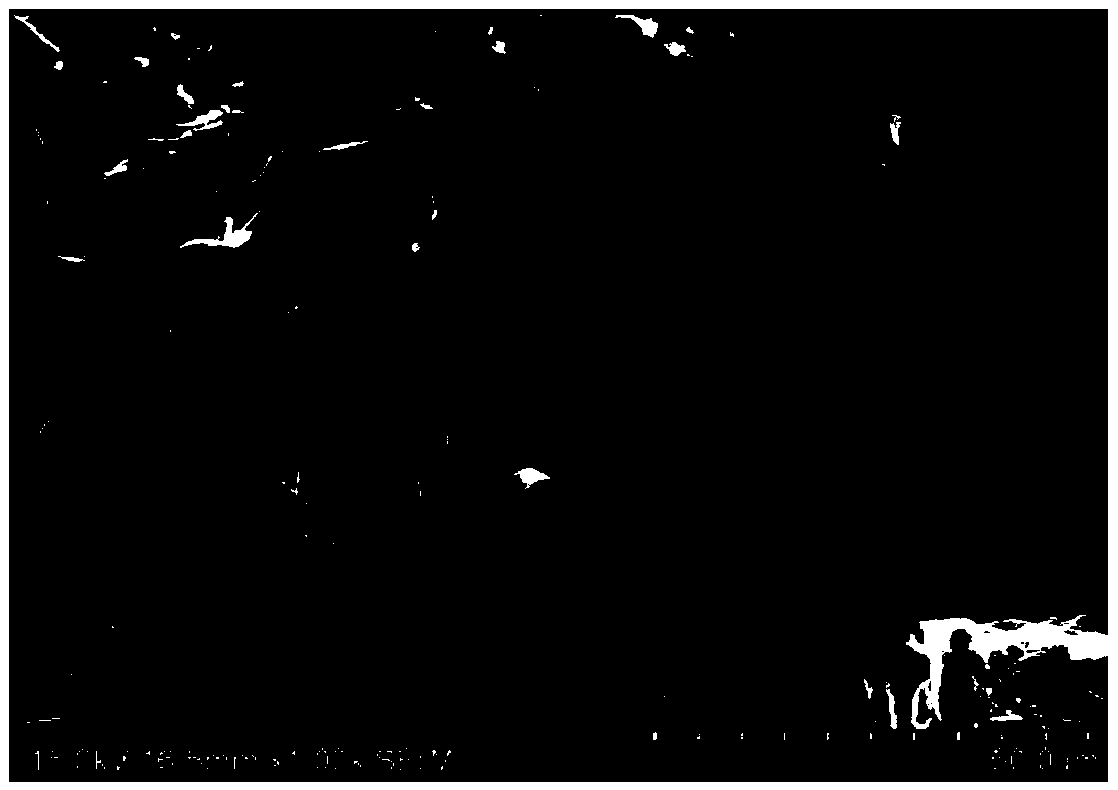Method for preparing sulfur-free expansible graphite
A technology of expanded graphite and graphite, applied in the field of composite material preparation, can solve the problems of high sulfur content and low sulfur, and achieve the effects of simple reaction, high yield and low cost
- Summary
- Abstract
- Description
- Claims
- Application Information
AI Technical Summary
Problems solved by technology
Method used
Image
Examples
preparation example Construction
[0017] The invention provides a method for preparing sulfur-free expandable graphite, the method comprising the following steps:
[0018] (1) Graphite and acid are carried out contact reaction, obtain mixture;
[0019] (2) carrying out the first expansion reaction to the mixture obtained through step (1), to obtain the first expanded graphite;
[0020] (3) performing a second expansion reaction on the first expanded graphite obtained in step (2).
[0021] Preferably, in the present invention, the graphite is natural phosphorus flake graphite, and the carbon content of the graphite is greater than or equal to 99.6% by weight (that is, ≥99.6% by weight), and the average particle size of the graphite is preferably 100- 350 mesh.
[0022] According to the present invention, the inventors of the present invention have found through a large number of scientific experiments that sulfur-free expandable graphite can be prepared by contacting graphite with acid.
[0023] Preferably, ...
Embodiment 1
[0044] (1) Mix the natural flake graphite (carbon content ≥ 99.99% by weight) with an average particle size of 325 meshes and perchloric acid with a concentration of 72% by weight, and put it into a reactor for contact reaction, wherein the natural flake graphite (a total of 15g) and perchloric acid are used in a weight ratio of 1:0.5; and the conditions for the contact reaction include: the reaction temperature is 38°C, and the duration is 40min;
[0045] (2) performing a first expansion reaction on the mixture obtained in step (1) under anaerobic conditions, the conditions of the first expansion reaction include: the temperature is 280° C., and the time is 40 minutes;
[0046] (3) After the first expanded graphite obtained in step (2) is cooled to room temperature, catalyst DGG is added therein to carry out the second expansion reaction; relative to the described graphite of 1 weight part, the consumption of the catalyst is 0.3 weight parts, and the conditions of the second ...
Embodiment 2
[0051](1) Mix the natural flake graphite (carbon content ≥ 99.98% by weight) with an average particle size of 325 meshes and perchloric acid with a concentration of 75% by weight, and put it into a reactor for contact reaction, wherein the natural flake graphite (a total of 15g) and perchloric acid are used in a weight ratio of 1:0.7; and the conditions for carrying out the contact reaction include: the reaction temperature is 40°C, and the duration is 42min;
[0052] (2) The mixture obtained in step (1) is subjected to a first expansion reaction under anaerobic conditions, the conditions of the first expansion reaction include: the temperature is 300° C., and the time is 44 minutes;
[0053] (3) After the first expanded graphite obtained in step (2) is cooled to room temperature, catalyst DGG is added therein to carry out the second expansion reaction; relative to the described graphite of 1 weight part, the consumption of the catalyst is 0.2 weight parts, and the conditions ...
PUM
| Property | Measurement | Unit |
|---|---|---|
| particle size | aaaaa | aaaaa |
Abstract
Description
Claims
Application Information
 Login to View More
Login to View More - R&D
- Intellectual Property
- Life Sciences
- Materials
- Tech Scout
- Unparalleled Data Quality
- Higher Quality Content
- 60% Fewer Hallucinations
Browse by: Latest US Patents, China's latest patents, Technical Efficacy Thesaurus, Application Domain, Technology Topic, Popular Technical Reports.
© 2025 PatSnap. All rights reserved.Legal|Privacy policy|Modern Slavery Act Transparency Statement|Sitemap|About US| Contact US: help@patsnap.com



